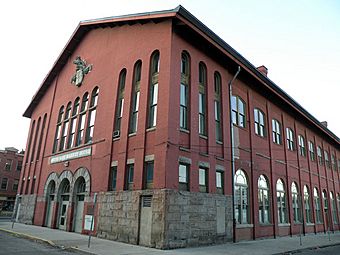South Side Market Building facts for kids
|
South Side Market Building
|
|
 |
|
| Location | 12th and Bingham Sts., Pittsburgh, Pennsylvania |
|---|---|
| Area | 1 acre (0.40 ha) |
| Built | 1915 |
| Architectural style | Richardsonian Romanesque, Romanesque, Italianate |
| NRHP reference No. | 76001600 |
Quick facts for kids Significant dates |
|
| Added to NRHP | October 14, 1976 |
The South Side Market Building, also known as the South Side Market House, is a special historic building located at 12th and Bingham Streets in the South Side Flats neighborhood of Pittsburgh, Pennsylvania. It was once a busy place where people bought and sold goods, like a big indoor market.
It was built in 1915. This building is so important that it was added to the National Register of Historic Places in 1976. This list includes buildings and places that are important to American history.
A Historic Market in Pittsburgh
The South Side Market Building is one of the last old market houses left in Pittsburgh. A market house is a large building where many different sellers gather to sell their products. Think of it like an early version of a shopping mall or a farmers' market, but all under one roof!
Its Story Through Time
The very first market building on this spot was built in 1893. It was a lively place where people could buy fresh food and other items. Sadly, this first building was destroyed by a fire around 1914.
But the community quickly rebuilt it! The new building, which is the one we see today, opened in 1915. The architect who designed it was Charles Bickel. He created a strong and interesting building that has stood for over a hundred years.
What Does It Look Like?
When the market building was rebuilt in 1915, some changes were made. For example, the towers that were on the original building were removed. The roof was also changed to come down closer to the edges of the building.
One special decoration was added to the south side of the building. It's a stone carving called a cartouche. This carving has a bull's head at the top, surrounded by decorative swags. It was put there to remember the new building and its history. The walls of the building are made in a style called Romanesque, which looks strong and solid.




